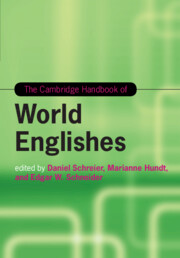Book contents
- The Cambridge Handbook of World Englishes
- Cambridge Handbooks in Language and Linguistics
- The Cambridge Handbook of World Englishes
- Copyright page
- Dedication
- Contents
- Figures
- Maps
- Tables
- Notes on Contributors
- 1 World Englishes: An Introduction
- Part I The Making of Englishes
- 2 The Colonial and Postcolonial Expansion of English
- 3 Theoretical Models of English as a World Language
- 4 The Contribution of Language Contact to the Emergence of World Englishes
- 5 Population Structure and the Emergence of World Englishes
- 6 World Englishes, Migration, and Diaspora
- Part II World Englishes Old and New
- Part III Linguistics and World Englishes
- Part IV Current Challenges
- Index
- References
5 - Population Structure and the Emergence of World Englishes
from Part I - The Making of Englishes
Published online by Cambridge University Press: 16 December 2019
- The Cambridge Handbook of World Englishes
- Cambridge Handbooks in Language and Linguistics
- The Cambridge Handbook of World Englishes
- Copyright page
- Dedication
- Contents
- Figures
- Maps
- Tables
- Notes on Contributors
- 1 World Englishes: An Introduction
- Part I The Making of Englishes
- 2 The Colonial and Postcolonial Expansion of English
- 3 Theoretical Models of English as a World Language
- 4 The Contribution of Language Contact to the Emergence of World Englishes
- 5 Population Structure and the Emergence of World Englishes
- 6 World Englishes, Migration, and Diaspora
- Part II World Englishes Old and New
- Part III Linguistics and World Englishes
- Part IV Current Challenges
- Index
- References
Summary
From a uniformitarian perspective, I interpret the emergence of Old English as the outcome of colonization and language contact. Likewise, I argue that its spread and speciation into so many varieties around the world, including creoles and pidgins, are consequences of different instances of colonization, which varied according to whether this involved settlement, exploitation, or trade. Each colonization style produced a different population structure, which in turn influenced how the language was appropriated and restructured by its non-heritage speakers. In England itself, one must invoke how the colonization of the land by other European nations subjected the language to the superstrate influence of the colonizers, who shifted to it. Ecological factors such as population structure (which determine patterns of social interactions and language transmission) and periodization (associated with particular moments of language shift or appropriation) help account for the differential evolution of English around the world.
Keywords
- Type
- Chapter
- Information
- The Cambridge Handbook of World Englishes , pp. 99 - 119Publisher: Cambridge University PressPrint publication year: 2020
References
- 13
- Cited by

